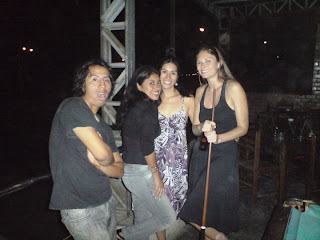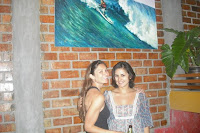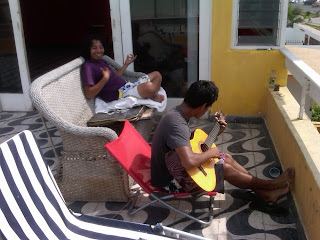A classic Trujillo COMBI
With Ru still confined to his bed and Anjana out of town for the week, Jean Paul and I headed to Uno A on Monday by ourselves.
Group photo with our youngest class in Uno A
So, just to give you the status of my roommates' health and general well being: Ruwan has an infected bug bite on his leg and was unable to participate in any activities for over a week, but he's healing and now back on his feet. JP is still coughing and unable to work or do anything that is physically demanding. Elizabeth's eye is no longer black and blue. Her shoulder and abdominal issues were on the mend until last night when she was attacked by 3 guys on the street who tried to steal her bag. Amazingly, Elizabeth was able to fight the three of them off (she even kicked one of them in the face!) but her shoulder was re-injured during the attempted robbery. We are all convinced that the Espaanglisch house is cursed and Anjana and I are crossing our fingers that the black cloud has lifted from 499 Calle Paraguay.
Last Tuesday, with all of the other Espaanglisch volunteers in bed, I headed to El Milagro with Norma, Lola, and Amy, who all work with USDA. I helped the kids with an art project and taught a brief lesson on food in English. After classes were over, I went back to Casona Deza for lunch by myself and started chatting with the owner, who was sitting out on the patio. After I finished eating, he offered to take me on a tour of the rest of the house, which he hopes to turn into a small boutique hotel within a few years. It turns out that Luis got into the restaurant/hospitality industry after he sold his two-way radio company to Nextel a few years ago....must be nice!
The next day, I was back in Uno A for my last day of teaching at that site. USDA invited a group of performers to the school to put on a puppet show for the kids, which they loved. Afterwards, several of the older women came to the school with food that they prepared for the group and everyone was treated to a free meal. All in all, it was a great end to my experience working in this neighborhood. That afternoon, Lola invited me to her house for lunch and I was fed for the second time that day by generous Peruvians.
Leading up to Thursday, the Espaanglisch crew had been planning a big fundraiser to benefit our school and USDA. The party was held on Thursday night at the Espaanglisch school in Huanchaco. After my last day of teaching in El Milagro, I headed out to the beach with Ru to help David get the space set up and hand out fliers to fun-looking gringos and tanning Peruvians. The event started off a bit rocky with the entire crew scrambling to run last minute errands and set up the bar, but by 11:30, the party was hopping with a heavily intoxicated, international crowd. When it was all said and done, we raised approximately S/. 2,000 (approx. $700) in one night for our programs.
Since most of us went to bed at dawn, we were all hurting on Friday. Luckily, I didn´t have to work until Compartiendos that night. I arrived with Carla and Joana to the plaza on Friday night and helped Teresa and some of the other volunteers assist the kids with another craft project. After feeding everyone, we went back to the USDA office to celebrate the February birthdays with a big cake and Fanta. Since it was my last night volunteering, Carla and Norma each gave a short speech and the entire USDA staff presented me with a certificate and a giant Peruvian chocolate bar. It was truly touching and I thanked everyone for making my experience in Trujillo so memorable.
The next morning, Ru, Billy, and I decided to have a cultural excursion and head out to Chan Chan, a combi stop on the way to Huanchaco, and the largest pre-Colombian city in the Americas (according to Lonely Planet). Unfortunately, flooding and erosion have left Chan Chan in a less-than-remarkable state. With much of the stone work destroyed, it is more a giant replica than a well-preserved archaeological site. Our tour guide, whose knowledge of Chan Chan resembled a poorly written Wikipedia article, dazzled us with such amazing facts as, ¨We used to think that these animal carvings were sea otters, but now we think that they were probably squirrels, because back in the olden times there were lots of trees here.¨ Or, ¨This wall used to be 12 meters high, but now it´s 4 meters high because of El Niño¨.
The Ruins at Chan Chan (just as unspectacular as this photo).
Ru and I doing our squirrel pose.
We left Chan Chan feeling hot and cheated, but the weather in Huanchaco was sublime and we lounged on the roof at Espaanglisch, taking photos and listening to music. We returned to Trujillo that night for dinner with the heads of USDA, who come from Switzerland a few times per year to check on the program and interact with the volunteers. Dinner was at a brightly lit Chifa (Chinese) restaurant and there was enough food to feed the entire city for a week. With our guts filled to the brim, a group of us took a taxi back to Huanchaco to see the Carnival parade. Several hundred people lined the main avenue along the beach as floats and costumed revelers marched by us. After taking in a bit of the spectacle, we headed back to our roof for an animated game of charades and a great view of the fireworks.
Anjana arrived back in Trujillo late on Saturday night, so went spent Sunday morning in the house sharing stories about the past week. We also met Sally, who had just arrived in Trujillo and will be taking my place when I leave at the end of the month. We spent the afternoon in Huanchaco and met up with Teresa and Joana for happy hour just in time to witness the most amazing sunset over the pier. Billy and Amber (Billy´s housemate and another fellow American from Alaska) met up with us for drinks and a carnivorous dinner at the restaurant next door.
Joana, Teresa, Me, Ru, and Anjana having a cocktail by the beach.
Yesterday morning, Anjana and I got up bright and early to take a surf lesson. It wasn´t a bad first attempt, seeing as I haven´t been surfing since I was in Australia 7 years ago. I have some nice battle wounds this morning to show for my efforts.
Step 2: Take Cheesy Picture by a Surfboard
Step 3: Hang Ten
Last night was my final adult English class. I said goodbye to my students and thanked them all for their attendance and patience. I will really miss teaching this group and I hope they all continue to come to classes here at Espaanglisch.
Today is my last day in Trujillo and I´ll spend the rest of it packing up my room and saying goodbye to friends. I hope you have all enjoyed reading about my experiences in South America. Traveling and volunteering in Ecuador and Peru has been an unforgettable adventure and I am truly sad to leave. The people I worked and lived with in Ecuador, my travel buddies, and the crew I met through Espaanglisch and USDA here in Trujillo made my time down here incredibly fulfilling. I hope you all keep in touch and come visit me if you are ever in Northern California.
I´m off to visit the Southern sites of Peru for two weeks. Stay tuned for photos and one last update after I get back to San Francisco in mid March.
¡Adiós por ahora!


































 View from the lawn
View from the lawn












